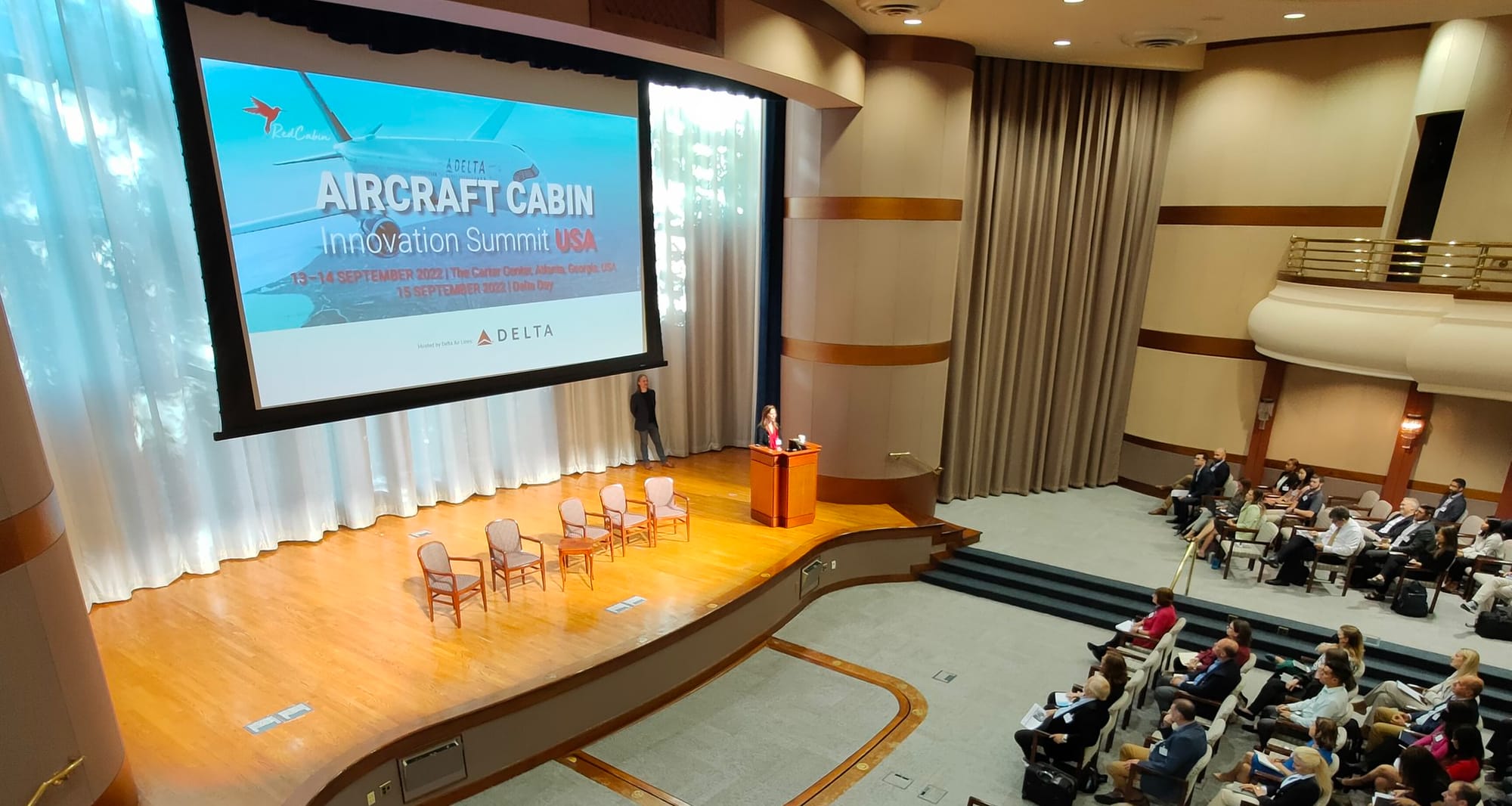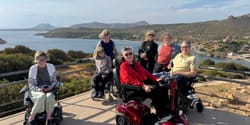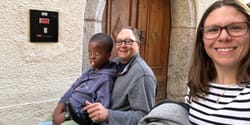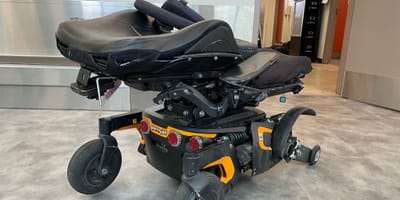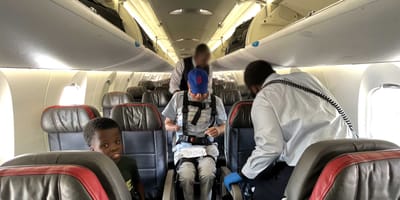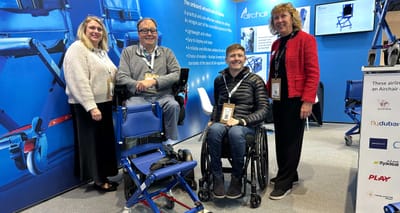The 2022 RedCabin Aircraft Cabin Innovation Summit, hosted at the Carter Center in Atlanta, Georgia last week, provided an excellent opportunity to connect with the designers and engineers responsible for the aircraft interiors of today (and tomorrow), as well as airlines, aircraft manufacturers and others connected to the commercial aviation industry.

RedCabin is more than a networking opportunity — the event brings industry experts together to share best practices and to collaborate in an environment designed to breed innovation. Together with industry colleagues, Christopher Wood from Flying Disabled and Timo Gumbert from FACC AG, I was invited to lead a series of workshops on accessibility that were attended by nearly 200 experts from across the industry.
These dedicated accessibility workshops, a first at RedCabin, produced dynamic conversations and innovative ideas. Attendees were keen to learn about the disabled passenger experience while leveraging their expertise to brainstorm accessibility improvements that can and should be incorporated into future aircraft cabin designs.
8 Innovative Ideas for an Accessible Airplane Cabin
During the accessibility workshops, attendees were asked to brainstorm ideas that could improve the disabled passenger experience in the aircraft cabin. We sought actionable ideas that could reasonably work within the aircraft types that are currently in service.
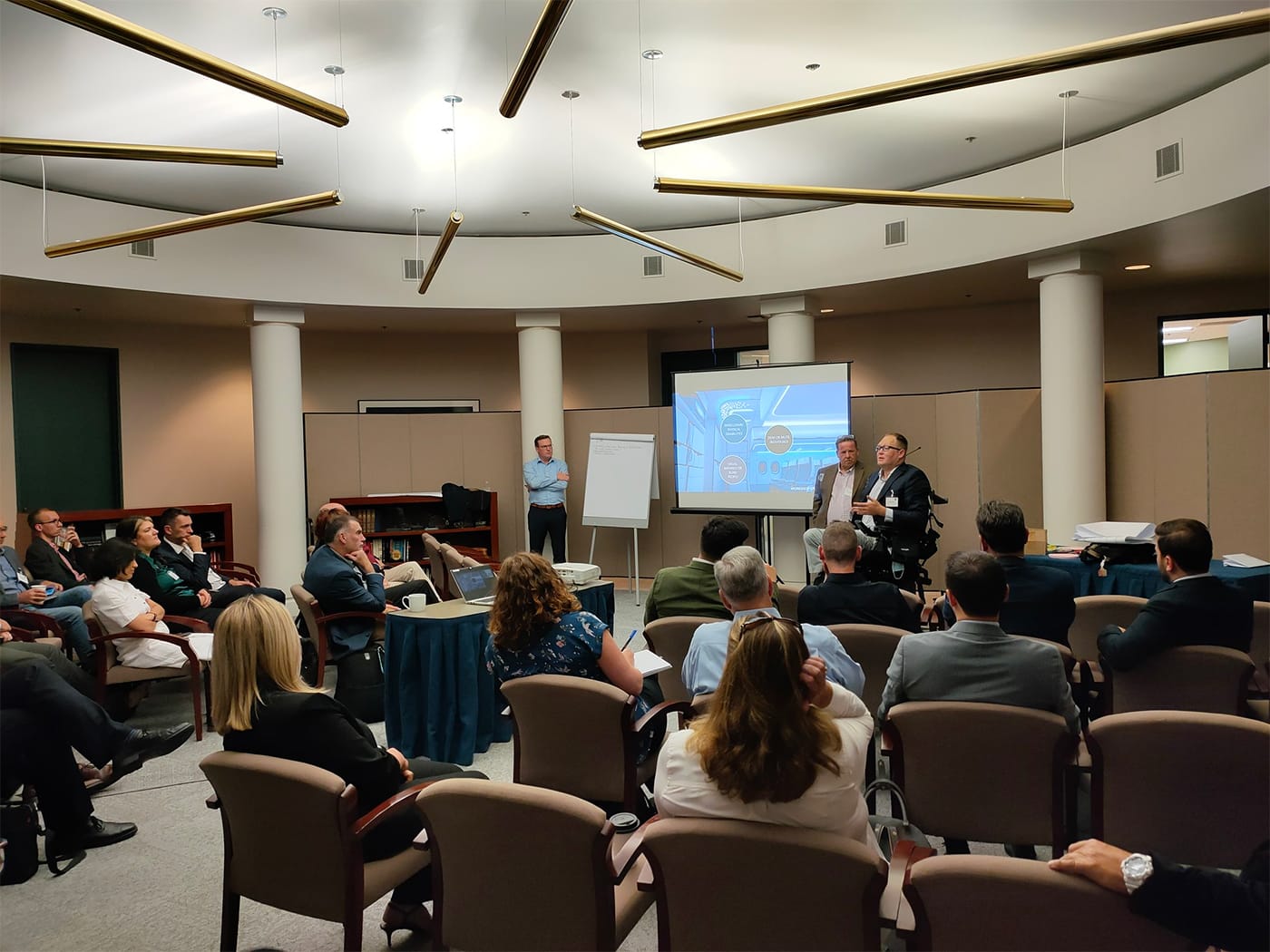
The following 8 ideas were the most promising — a business case can be made for each of them and would allow airlines to outpace potential government regulation.
Removing the quotation marks from “Accessible Lavatories”
The availability of accessible toilets is considered by many to be a human rights issue and, despite recent improvements in accessible bathroom design on trains, the aviation industry continues to lag behind.
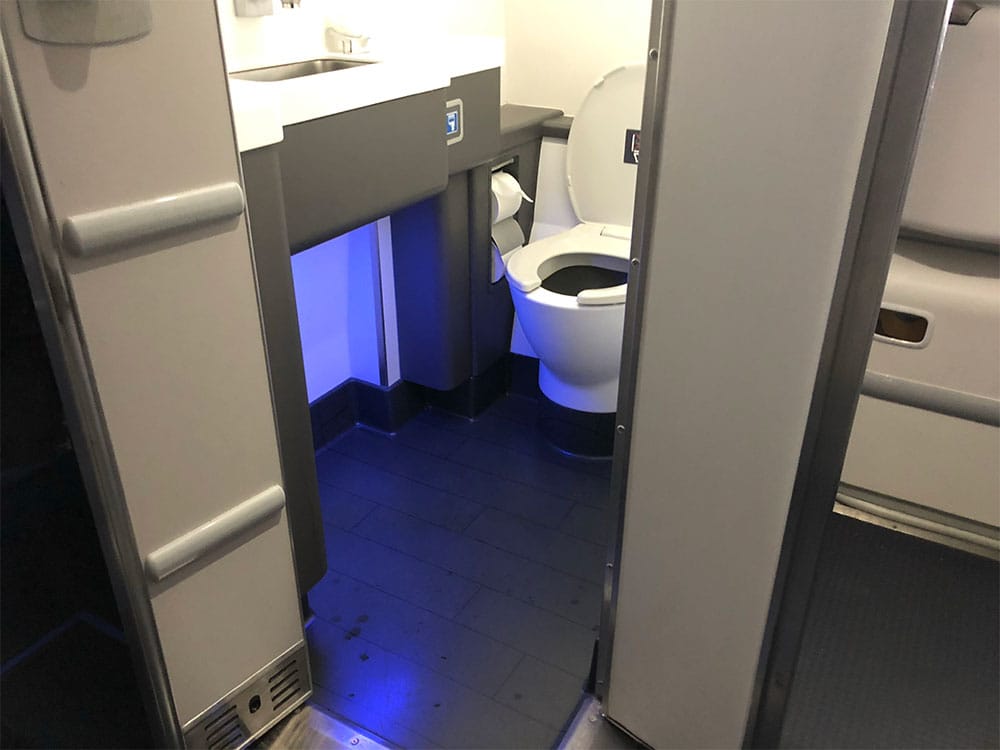
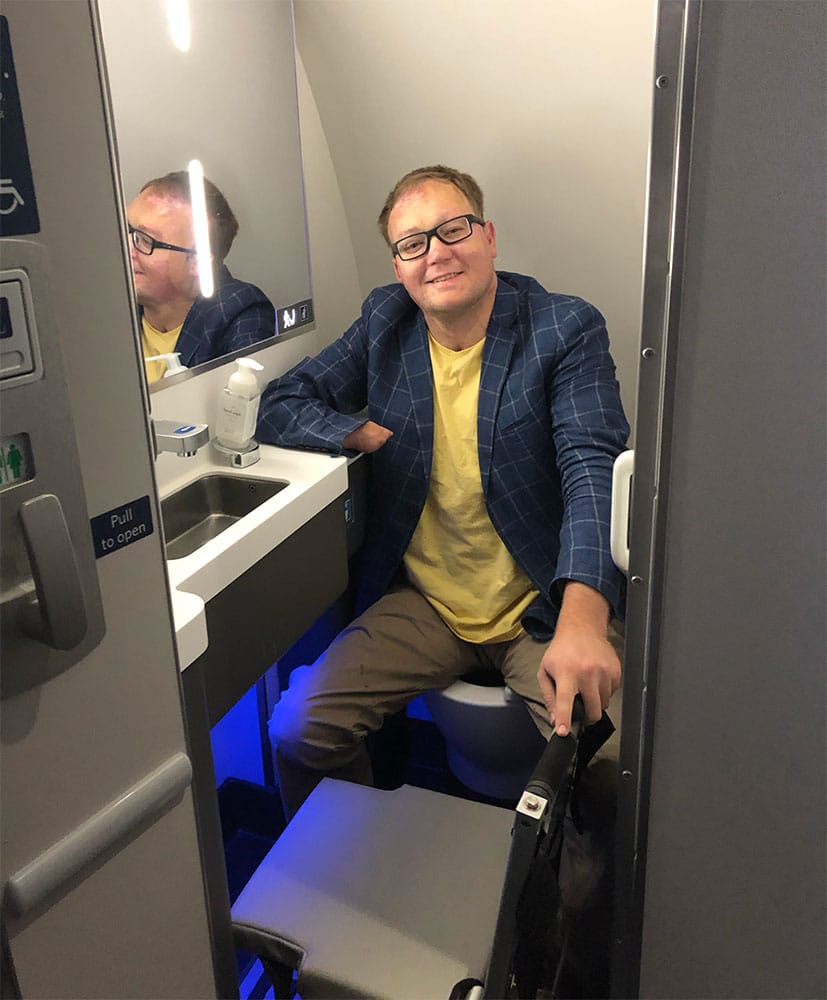
One attendee brought up a previous WheelchairTravel.org article on the Airbus A220’s accessible lavatory, suggesting along with others that it may not go far enough to advance true accessibility. The constraints on space in the aircraft cabin are typically referenced as a barrier to truly accessible lavatories. I asked the group, could this be overcome by reducing the number of lavatories on aircraft to create a larger accessible facility?
On many wide body aircraft, a folding wall between two standard lavatories opens to create a larger space. While this provides room to accommodate the onboard aisle chair, the second toilet inhibits access for many disabled travelers and their carers. Since there is no regulation requiring more than a single toilet onboard a commercial aircraft, the space used for two standard lavatories could reasonably be repurposed to create a single accessible bathroom within the same footprint (or an adjusted one).
Wheelchair securement space on airplanes
U.S. Department of Transportation Secretary Pete Buttigieg recently made the following comments about passengers sitting in their own wheelchairs on airplanes:
“No other form of transportation — trains, buses, boats — forces you to give up your mobility device when you board. The same ought to be true of airlines. So, in the months and years ahead, we plan to record a new rule that will allow passengers to stay in their personal wheelchairs when they fly. We know this won’t happen overnight, but it is a goal that we have to work to fulfill.”
Secretary Pete Buttigieg
Secretary Buttigieg’s words follow years of advocacy by groups like All Wheels Up and Flying Disabled to demonstrate the feasibility of wheelchair securement spaces on airplanes.

During the RedCabin accessibility workshops, the feature was discussed as a way for carriers to reduce liability around damage to wheelchairs, passenger injury and even death, as was the case with disability rights activist Engracia Figueroa.
One such concept, the Air4All wheelchair securement system, will permit power wheelchairs to be secured in the aircraft cabin without compromising the available number of seats. Many wheelchairs already meet or exceed the crash test requirements of airline seats and, with some adjustments, could potentially be secured using the Air4All system.
Interchangeable seat cushions
Airline seats are hard and prove a hazard for disabled people who rely on specialized seat cushions for pressure relief. Due to the small size of many airline seats, particularly in economy class, most wheelchair cushions can’t be used during flight.
One attendee proposed a specially designed pressure relief cushion with additional padding that could be swapped with the seat cushion installed on the aircraft. Such a cushion could be provided by the airline to passengers needing additional support on account of their disability, or it could be supplied by the passenger. Pressure sores are deadly, and the developers of airline and wheelchair seating systems should collaborate on this concept.
Hearing loop equipped aircraft
A number of airports have recently installed hearing induction loops at boarding gates to ensure those who use t-coil enabled hearing aids receive clear announcements relating to their flight.
This capability should extend to the air, where passengers with auditory challenges have a right to receive announcements from pilots and cabin crew (including the dreaded credit card pitch) in an accessible format. In an emergency, a hearing loop could prove to be a life-saving safety feature.
ATR, the turboprop manufacturer jointly owned by Airbus and Leonardo, unveiled its plans for hearing loop equipped aircraft at AIX 2019. Aircraft manufacturers — and airlines — need to get onboard with making this key accessibility feature a reality.
In-flight entertainment with closed captions
Many carriers now offer closed captioning on some portion of the movies and TV shows included in their libraries of inflight entertainment, but captions remain absent from live television. Oscar-winning actress Marlee Matlin pointed this out in a tweet to Delta Air Lines last week:
There is also an opportunity to transcribe inflight announcements for display on seatback entertainment screens, ensuring that important information is made available to deaf and hard of hearing travelers in an accessible format.
Height-adjustable onboard aisle chair
Disabled passengers who require use of the aisle chair often describe the trip to their seat as a “boxing match.” As a formerly 6’3″ guy with broad shoulders who now uses a wheelchair, I know this all too well: my shoulders hit every seat on trips up and down the aisle.
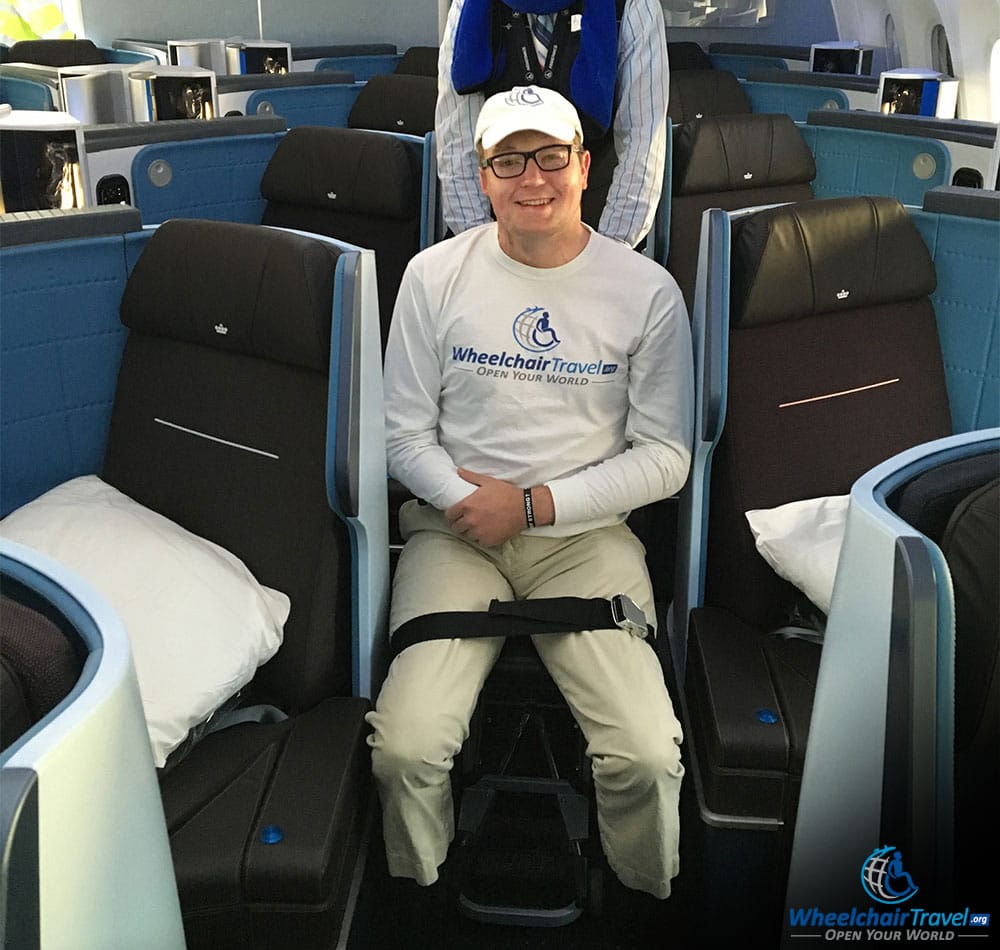
Most attendees had never considered aisle width as a real problem. “My shoulders are above the seat when I walk down the aisle,” said an engineer, while another added, “It’s not something we’ve ever considered or designed for.”
Although wider aisles could solve the problem, that would come at the cost of seat width and isn’t likely to gain support from airlines — at least not with existing airframes. The solution our working group proposed was a height-adjustable aisle chair to elevate the passenger (and my wide shoulders!) above the seats. With the USDOT encouraging the development of aisle chairs that offer more safety and support, now is the time to research this innovation.
Aira in the air
Aira is a smartphone application and service that provides on-demand visual interpreting, connecting users to humans who describe one’s visual surroundings using the smartphone’s camera. It is a game-changer in accessibility for blind people and those with limited vision.
Many airports, transit systems, museums, universities and businesses (including Starbucks!) subsidize the cost of Aira for their customers and employees, providing a new means of promoting equal access for all. With high-speed internet connectivity making its way onto airliners across the world, perhaps there is a space for Aira to help disabled passengers navigate the aircraft cabin?
While some adjustment to federal regulations will be necessary to permit the video calling required to use Aira, it’s a perfectly reasonable accommodation that would make the aircraft cabin significantly more accessible to blind passengers.
Control the cabin through a smartphone app
When passengers connect to onboard wi-fi networks, they’re often greeted with flight information, duty-free shopping and a bevy of entertainment options. Some airlines even allow customers to place food orders directly from their smartphones.
This same technology could be used to provide greater accessibility to disabled passengers in the aircraft cabin. For those with limited mobility, vision, hearing or dexterity, the ability to request assistance or control seat functions using a familiar device could be a game-changer. With the proper software, passengers could communicate with cabin crew and control aircraft features (reading light, seat recline, IFE, window shade, etc.) through the airline’s smartphone app or a web-based portal.
Final thoughts and the key to sustaining accessible innovation
RedCabin is an event unlike any other in that it brings the greatest minds from the aviation industry together — colleagues and competitors — to tackle tough problems through collaborative innovation, working groups and brainstorming sessions. I’m grateful to the team at RedCabin for welcoming me, and for the willingness of attendees to engage in challenging conversations that identified accessibility barriers and opportunities for improvement. Courageous leadership will be needed to guarantee equal access for all in the aircraft cabin, but summits like this one prove that the work is already underway.
If you’d like to support my efforts to present the business case for improved accessibility at travel industry conferences like this one, please consider making a donation. Your contributions make it possible for me to have a seat at the table and advocate for a more inclusive world.

